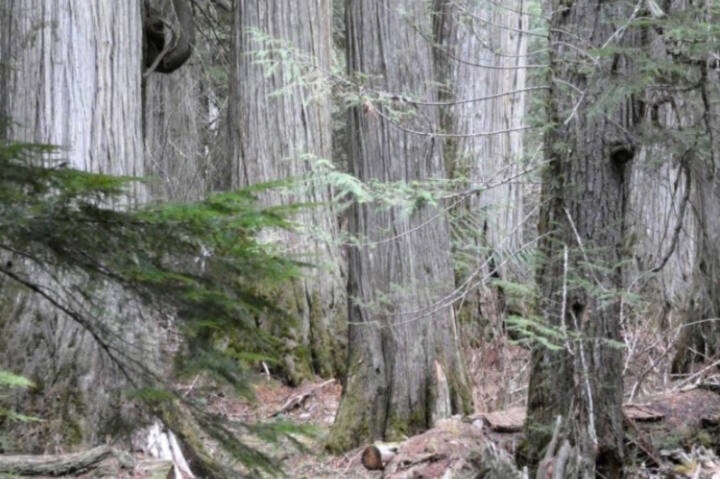The Regional District of Bulkley-Nechako natural resources committee recently received an update on the continued implementation of old growth forest deferral.
Nadina Natural Resource District, District Manager Beth Eagles and Skeena Regional Executive Director Jevan Hanchard were present, and Luke Weyman, Ministry of Forests Land and Resource Specialist, led a presentation to provide the update and answer questions.
At this point, the province in still in the process of implementing recommendations one and six of the 14 recommendations in the old growth strategic review, a document that was released in 2020 which. The province began implementing the recommendations after an announcement in November, 2021.
Recommendation one is a commitment to partnership with Indigenous nations and recommendation six is deferral of old growth areas at risk of irreversible biodiversity loss, which were identified by a technical advisory panel (TAP).
Irreversible biodiversity loss means a permanent loss of the animal, plant and fungi life that make up an area. Old growth forests typically have greater biodiversity than younger forests, according to Weyman.
As the province continues to receive responses from First Nations about the deferrals, Weyman acknowledged that communication has been lacking throughout the process.
“Roll out of recommendation six wasn’t done with a collaborative approach with [First] Nations up front, and there have been challenges that have come with that. The polygons [areas of old growth identified for deferral by TAP] weren’t informed by conversations with nations in advance,” he told the committee.
“I’m hopefully that the initial roll out is not consistent with the way the rest of the recommendations are implemented moving forward,” he continued.
Weyman also addressed the immediate impacts to the communities, which have been caused by B.C. Timber Sales already having adopted deferring areas identified by the TAP.
READ MORE: Impacts of old growth deferral on Burns Lake
“In terms of impacts to communities, we’ve heard a lot of concerns from local governments and licensees about impacts on local jobs, forest industry, and what that might do to communities. With B.C. Timber Sales adopting the deferrals, any of the timber sales licenses that overlap those polygons have had logging deferred, and that’s reducing fiber availability in the north. Across the Skeena business area, about 250,000 cubic meters have been deferred. This is impacting smaller mills that don’t have licences of their own and are dependent on timber sales licenses,” he said.
The Skeena business area is one of the 12 B.C. Timber Sales business areas in the province. It does not actually encompass Burns Lake, though the impacts are still felt here because the deferrals are causing an increase in competition in the area for forest supplies that are available.
In terms of polygons that relate to First Nations groups along the Highway 16 corridor, responses about the deferrals have been more on the non-committal side according to Weyman.
“A lot of nations along the Highway 16 corridor have tenure of their own and have strong economic interests, and they’ve raised concern about impacts to their economic interests in responding to the deferral question, whereas other nations that are in the north may not actually have much forest industry, or old growth areas are so remote that it won’t have an immediate impact. The response to the deferral question has been varied and nuanced depending on what nation we’ve talked too,” he said.
Committee members Dolores Funk and Shane Brienen mentioned similar testaments about First Nations in the region during the presentation.
“My understanding is that in the Lakes timber supply area, a number of the First Nations are intending to opt out of the deferral process. I think that the pressure from all the deferrals being in place has been released a little bit in our area,” Funk said.
READ MORE: Impacts of old growth deferral on Burns Lake
“Over the regional district, the answers that we’ve heard in this engagement with [First] Nations has largely been either; not directly supportive of the polygons, not supportive of implementing them, or that the [First] Nations are looking for more information and more time or existing processes that we’ve already engaged in,” said Brienen
The official responses of the First Nations groups within the region have yet to be released by the province, though in theory, should local First Nations that have overlapping timber sales licenses in polygons be aligned in a non-committal response, then deferrals would not happen in those polygons.
At the conclusion of his presentation, Weyman reiterated that communication to local governments and communities needs to be better.
READ MORE: B.C. old-growth forest preservation plan off to a slow start for 2022
“To date there hasn’t been the greatest public information because there’s been a lot of moving and evolving pieces and not always the most concrete info to share, but now we have more clarity on how recommendation six has been received by [First] Nations. We’re getting more clarity about their responses and were getting a better understanding of how all 14 recommendations are going to be implemented. In the coming months we’re going to see more concrete messages being shared with the public about how this process is going to work.
Have a story tip? Email:
Eddie Huband
Multimedia Reporter
eddie.huband@ldnews.net
Like us on Facebook and follow us on Twitter.
